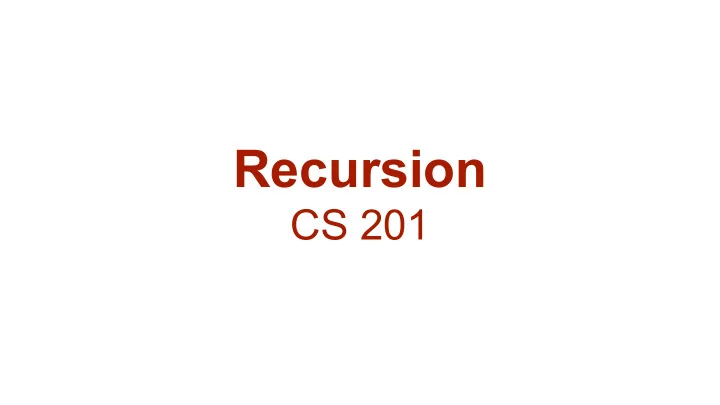

Recursion CS 201
Introduction ● Recursion is an extremely powerful problem-solving technique ○ It breaks a problem into smaller identical problems and uses the same function to solve these smaller problems ○ It is an alternative to iterative solutions, which use loops ● Facts about recursive solutions ○ A recursive function calls itself ○ Each recursive call solves an identical but a smaller problem ○ Base case must be defined (it enables to stop the recursive calls) ○ Eventually, one of the smaller problems must be the base case 2
Simple example: Write a global function that displays a given C-style string backward Recursive solution: ● Each recursive call diminishes the string length by 1 ● Base case: displaying the empty string backward void displayBackward( char* str ) { if ( str[0] == '\0' ) return; displayBackward( str + 1 ); cout << str[0]; }
Recursion and efficiency: Fibonacci function int recursiveFib( int n ) { Recurrence relation: if ( n <= 2 ) F( n ) = F( n - 1 ) + F( n - 2 ) return 1; return recursiveFib( n - 1) + recursiveFib( n - 2 ); Base cases: } F( 1 ) = 1 int iterativeFib( int n ) { F( 2 ) = 1 int previous = 1; int current = 1; int next = 1; // result when n is 1 or 2 // compute next Fibonacci values when n >= 3 for ( int i = 3; i <= n; i++ ) { next = current + previous; previous = current; current = next; } return next; }
Recursion and efficiency ● Some recursive solutions are so inefficient that they should not be used ● Factors contributing to this inefficiency ○ Inherent inefficiency of some recursive algorithms (such as the recursiveFib function) ○ Overhead associated with function calls ● Do not use a recursive solution if it is inefficient and there is a clear and efficient iterative solution 5
More examples: Write a recursive function for the binary search algorithm A high-level pseudocode for binary search if ( anArray is of size 1 ) determine if anArray’s item is equal to the searched value else { find the midpoint of anArray determine which half of anArray contains the searched value if ( the value is in the first half of anArray ) binarySearch( first half of anArray, value ) else binarySearch( second half of anArray, value ) } Implementation issues ● How to pass “half of anArray ” to the function? ● How to determine the base case(s)? ● How to return the result?
More examples: Write a recursive function for the binary search algorithm int binarySearch( int* arr, int low, int high, int key ) { if ( low > high ) return -1; int mid = (low + high) / 2; if ( arr[mid] == key ) return mid; if ( arr[mid] > key ) return binarySearch( arr, low, mid - 1, key ); return binarySearch( arr, mid + 1, high, key ); }
More examples: Write a recursive function that finds the connected components of a given black-and-white image Application 1: Suppose that we want to locate cell nuclei in a gray-level image whose pixel intensities are in between 0 and 255. To find the nucleus locations, one may first obtain a black-and-white image, whose intensities are either 0 or 1, using some image processing techniques (e.g., thresholding). Then, s/he may identify each connected component of the 1-pixels as a cell nucleus.
More examples: Write a recursive function that finds the connected components of a given black-and-white image Application 2: Similarly, in the image below, we want to identify individual buildings. Connected component analysis can be used after obtaining a black-and-white image of buildings.
More examples: Write a recursive function that finds the connected components of a given black-and-white image int** findConnectedComponents( int** arr, int row, int column ) { int** labels, i, j, currLabel; labels = new int* [ row ]; for ( i = 0; i < row; i++ ) { labels[ i ] = new int [ column ]; for ( j = 0; j < column; j++ ) labels[ i ][ j ] = 0; } currLabel = 1; for ( i = 0; i < row; i++ ) for ( j = 0; j < column; j++ ) if ( arr[ i ][ j ] && !labels[ i ][ j ] ) fourConnectivity( arr, labels, row, column, i, j, currLabel++ ); return labels; }
More examples: Write a recursive function that finds the connected components of a given black-and-white image void fourConnectivity( int** arr, int** labels, int row, int column, int i, int j, int currLabel ) { if ( arr[i][j] == 0 ) return; if ( labels[i][j] > 0 ) return; labels[i][j] = currLabel; if ( i - 1 >= 0 ) fourConnectivity( arr, labels, row, column, i - 1, j, currLabel ); if ( i + 1 < row ) fourConnectivity( arr, labels, row, column, i + 1, j, currLabel ); if ( j - 1 >= 0 ) fourConnectivity( arr, labels, row, column, i, j - 1, currLabel ); if ( j + 1 < column ) fourConnectivity( arr, labels, row, column, i, j + 1, currLabel ); }
Recommend
More recommend